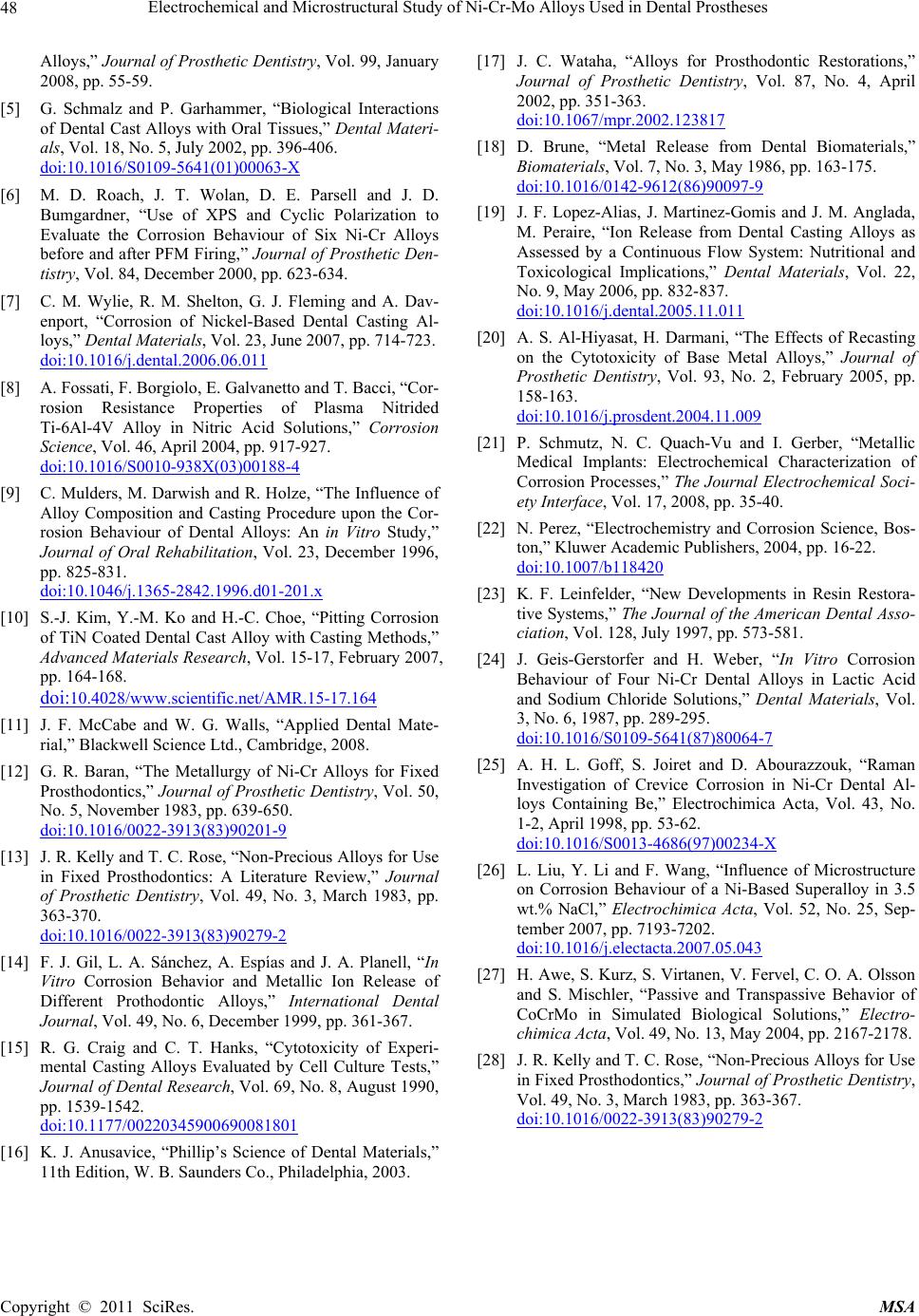
Electrochemical and Microstructural Study of Ni-Cr-Mo Alloys Used in Dental Prostheses
Copyright © 2011 SciRes. MSA
48
Alloys,” Journal of Prosthetic Dentistry, Vol. 99, January
2008, pp. 55-59.
[5] G. Schmalz and P. Garhammer, “Biological Interactions
of Dental Cast Alloys with Oral Tissues,” Dental Materi-
als, Vol. 18, No. 5, July 2002, pp. 396-406.
doi:10.1016/S0109-5641(01)00063-X
[6] M. D. Roach, J. T. Wolan, D. E. Parsell and J. D.
Bumgardner, “Use of XPS and Cyclic Polarization to
Evaluate the Corrosion Behaviour of Six Ni-Cr Alloys
before and after PFM Firing,” Journal of Prosthetic Den-
tistry, Vol. 84, December 2000, pp. 623-634.
[7] C. M. Wylie, R. M. Shelton, G. J. Fleming and A. Dav-
enport, “Corrosion of Nickel-Based Dental Casting Al-
loys,” Dental Materials, Vol. 23, June 2007, pp. 714-723.
doi:10.1016/j.dental.2006.06.011
[8] A. Fossati, F. Borgiolo, E. Galvanetto and T. Bacci, “Cor-
rosion Resistance Properties of Plasma Nitrided
Ti-6Al-4V Alloy in Nitric Acid Solutions,” Corrosion
Science, Vol. 46, April 2004, pp. 917-927.
doi:10.1016/S0010-938X(03)00188-4
[9] C. Mulders, M. Darwish and R. Holze, “The Influence of
Alloy Composition and Casting Procedure upon the Cor-
rosion Behaviour of Dental Alloys: An in Vitro Study,”
Journal of Oral Rehabilitation, Vol. 23, December 1996,
pp. 825-831.
doi:10.1046/j.1365-2842.1996.d01-201.x
[10] S.-J. Kim, Y.-M. Ko and H.-C. Choe, “Pitting Corrosion
of TiN Coated Dental Cast Alloy with Casting Methods,”
Advanced Materials Research, Vol. 15-17, February 2007,
pp. 164-168.
doi:10.4028/www.scientific.net/AMR.15-17.164
[11] J. F. McCabe and W. G. Walls, “Applied Dental Mate-
rial,” Blackwell Science Ltd., Cambridge, 2008.
[12] G. R. Baran, “The Metallurgy of Ni-Cr Alloys for Fixed
Prosthodontics,” Journal of Prosthetic Dentistry, Vol. 50,
No. 5, November 1983, pp. 639-650.
doi:10.1016/0022-3913(83)90201-9
[13] J. R. Kelly and T. C. Rose, “Non-Precious Alloys for Use
in Fixed Prosthodontics: A Literature Review,” Journal
of Prosthetic Dentistry, Vol. 49, No. 3, March 1983, pp.
363-370.
doi:10.1016/0022-3913(83)90279-2
[14] F. J. Gil, L. A. Sánchez, A. Espías and J. A. Planell, “In
Vitro Corrosion Behavior and Metallic Ion Release of
Different Prothodontic Alloys,” International Dental
Journal, Vol. 49, No. 6, December 1999, pp. 361-367.
[15] R. G. Craig and C. T. Hanks, “Cytotoxicity of Experi-
mental Casting Alloys Evaluated by Cell Culture Tests,”
Journal of Dental Research, Vol. 69, No. 8, August 1990,
pp. 1539-1542.
doi:10.1177/00220345900690081801
[16] K. J. Anusavice, “Phillip’s Science of Dental Materials,”
11th Edition, W. B. Saunders Co., Philadelphia, 2003.
[17] J. C. Wataha, “Alloys for Prosthodontic Restorations,”
Journal of Prosthetic Dentistry, Vol. 87, No. 4, April
2002, pp. 351-363.
doi:10.1067/mpr.2002.123817
[18] D. Brune, “Metal Release from Dental Biomaterials,”
Biomaterials, Vol. 7, No. 3, May 1986, pp. 163-175.
doi:10.1016/0142-9612(86)90097-9
[19] J. F. Lopez-Alias, J. Martinez-Gomis and J. M. Anglada,
M. Peraire, “Ion Release from Dental Casting Alloys as
Assessed by a Continuous Flow System: Nutritional and
Toxicological Implications,” Dental Materials, Vol. 22,
No. 9, May 2006, pp. 832-837.
doi:10.1016/j.dental.2005.11.011
[20] A. S. Al-Hiyasat, H. Darmani, “The Effects of Recasting
on the Cytotoxicity of Base Metal Alloys,” Journal of
Prosthetic Dentistry, Vol. 93, No. 2, February 2005, pp.
158-163.
doi:10.1016/j.prosdent.2004.11.009
[21] P. Schmutz, N. C. Quach-Vu and I. Gerber, “Metallic
Medical Implants: Electrochemical Characterization of
Corrosion Processes,” The Journal Electrochemical Soci-
ety Interface, Vol. 17, 2008, pp. 35-40.
[22] N. Perez, “Electrochemistry and Corrosion Science, Bos-
ton,” Kluwer Academic Publishers, 2004, pp. 16-22.
doi:10.1007/b118420
[23] K. F. Leinfelder, “New Developments in Resin Restora-
tive Systems,” The Journal of the American Dental Asso-
ciation, Vol. 128, July 1997, pp. 573-581.
[24] J. Geis-Gerstorfer and H. Weber, “In Vitro Corrosion
Behaviour of Four Ni-Cr Dental Alloys in Lactic Acid
and Sodium Chloride Solutions,” Dental Materials, Vol.
3, No. 6, 1987, pp. 289-295.
doi:10.1016/S0109-5641(87)80064-7
[25] A. H. L. Goff, S. Joiret and D. Abourazzouk, “Raman
Investigation of Crevice Corrosion in Ni-Cr Dental Al-
loys Containing Be,” Electrochimica Acta, Vol. 43, No.
1-2, April 1998, pp. 53-62.
doi:10.1016/S0013-4686(97)00234-X
[26] L. Liu, Y. Li and F. Wang, “Influence of Microstructure
on Corrosion Behaviour of a Ni-Based Superalloy in 3.5
wt.% NaCl,” Electrochimica Acta, Vol. 52, No. 25, Sep-
tember 2007, pp. 7193-7202.
doi:10.1016/j.electacta.2007.05.043
[27] H. Awe, S. Kurz, S. Virtanen, V. Fervel, C. O. A. Olsson
and S. Mischler, “Passive and Transpassive Behavior of
CoCrMo in Simulated Biological Solutions,” Electro-
chimica Acta, Vol. 49, No. 13, May 2004, pp. 2167-2178.
[28] J. R. Kelly and T. C. Rose, “Non-Precious Alloys for Use
in Fixed Prosthodontics,” Journal of Prosthetic Dentistry,
Vol. 49, No. 3, March 1983, pp. 363-367.
doi:10.1016/0022-3913(83)90279-2